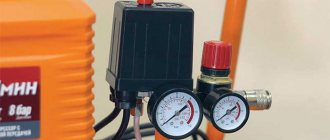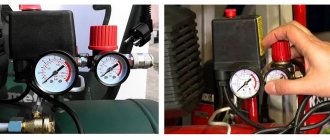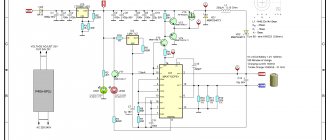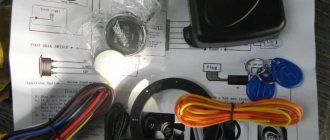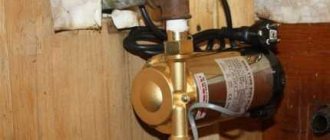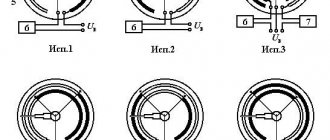The use of an air pneumatic relay allows you to automate the filling of the compressor receiver with compressed gas. The operator of equipment with a pressure switch does not need to monitor the process, trying to fix the limit parameters. As a result, engine damage is prevented. Significant results, right?
If you are planning to purchase a pressure switch for your compressor, then you have come to the right place. Here you will find a vast amount of extremely useful information about the principles of operation of the device, its configuration and connection methods.
We have described in detail the existing types of pneumatic relays. They provided options for connecting to a household and industrial network with extremely clear diagrams. We looked at typical breakdowns and ways to prevent them. The information and useful tips we provide are supplemented with graphic, photo and video applications.
Operating principle of a pressure switch
The name of the relay is determined by its purpose - controlling a piston compressor to maintain the required atmospheric pressure in the receiver. It is rarely found on a screw type device responsible for compressing and supplying air.
I take into account the magnitude of the pressing force in pneumatic automation; the device acts on the voltage line, closing or opening it. Thus, insufficient pressure in the compressor starts the motor, and when the required level is reached, it turns it off.
This standard operating principle, based on connecting a normal closed loop to a circuit, is used to control the motor.
The design of all ejectors contains a cylinder containing air at a certain pressure. Reducing it requires turning on the engine to replenish the supply. If the situation is the opposite and an excess is detected, the supply is stopped so that the container does not burst. These processes are controlled by a pressure switch
Modifications with the opposite operating algorithm are also presented: when reaching minimum values in the compression circuit, the pressure switch turns off the electric motor, and at maximum values it activates. Here the system operates in a normally open loop.
The operating system is made up of spring mechanisms with varying degrees of rigidity, reproducing the response to fluctuations in the air pressure unit.
During operation, the indicators formed as a result of the elastic force of tension or compression of the springs and the pressure of the atmosphere pressed by the device are compared. Any changes automatically activate the action of the spiral and the relay unit connects or disconnects the electricity supply line.
However, it is worth considering that the design of the review model does not provide for regulatory influence. Exceptional impact on the engine. In this case, the user has the opportunity to set a peak value, upon reaching which the spring will fire.
Adjusting the compressor pressure
As mentioned above, after creating a certain level of air compression in the receiver, the pressure switch turns off the unit’s engine. Conversely, when the pressure drops to the switching limit, the relay starts the engine again.
Important! By default, relays, both single-phase devices and units operating from a 380 V network, already have factory settings. The difference between the lower and upper engine start threshold does not exceed 2 bar. It is not recommended for the user to change this value.
But often situations that arise force you to change the factory settings of the pressure switch and adjust the pressure in the compressor at your discretion. You can only change the lower switching threshold, since after changing the upper switching threshold upward, the air will be released by the safety valve.
Pressure adjustment in the compressor is carried out as follows.
- Turn on the unit and record the pressure gauge readings at which the engine turns on and off.
- Be sure to disconnect the device from the power supply and remove the cover from the pressure switch.
- After removing the cover, you will see 2 bolts with springs. The large bolt is often designated by the letter “P” with the signs “-” and “+” and is responsible for the upper pressure, upon reaching which the device will be turned off. To increase the level of air compression, turn the regulator towards the “+” sign, and to decrease it, turn towards the “-” sign. First, it is recommended to make half a turn with the screw in the desired direction, then turn on the compressor and check the degree of pressure increase or decrease using a pressure gauge. Record at what indicators of the device the engine will turn off.
- Using a small screw you can adjust the difference between the on and off thresholds. As mentioned above, it is not recommended that this interval exceed 2 bars. The longer the interval, the less often the device’s engine will start. In addition, the pressure drop in the system will be significant. Setting the on-off threshold difference is done in the same way as setting the upper on-off threshold.
In addition, you need to configure the gearbox if it is installed in the system. It is necessary to set the compression level on the gearbox to a level that corresponds to the operating pressure of the pneumatic tool or equipment connected to the system.
Source
Complete set of compressor automation unit
The relay design is a small-sized block equipped with receiving pipes, a sensing element (spring) and a membrane. Mandatory subassemblies include an unloading valve and a mechanical switch.
The pressure switch sensing unit is made up of a spring mechanism, the compression force of which is changed by a screw. According to the factory standardized settings, the elasticity coefficient is set to a pressure in the pneumatic chain of 4-6 at, as reported in the instructions for the device.
Inexpensive models of ejectors are not always equipped with relay automation since such devices are mounted on the receiver. However, during long-term operation, to eliminate the problem of overheating of engine elements, it makes sense to install a pressure switch
The degree of rigidity and flexibility of the spring elements is subject to the temperature of the environment, therefore absolutely all models of industrial devices are designed for stable operation in an environment from -5 to +80 ºC.
The reservoir membrane is connected to the relay switch. During movement, it turns the pressure switch on and off.
The unloading unit is connected to the air supply line, which allows excess pressure to be released into the atmosphere from the piston compartment. This relieves the moving parts of the compressor from excessive force.
The unloading element is located between the ejector check valve and the compression block. If the motor drive stops working, the unloading section is activated, through which excess pressure (up to 2 atm) is released from the piston compartment.
With further start or acceleration of the electric motor, a pressure is created that closes the valve. This prevents overloading of the drive and simplifies starting the device in switched off mode.
There is an unloading system with a time interval of activation. The mechanism remains in the open position when the engine starts for a specified period. This range is enough for the engine to achieve maximum torque.
A mechanical switch is required to start and stop the automatic system options. As a rule, it has two positions: “on.” and "off". The first mode turns on the drive and the compressor operates according to the established automatic principle. The second one prevents accidental starting of the engine, even when the pressure in the pneumatic system is low.
Shut-off valves allow you to avoid emergency situations when elements of the control circuit fail, for example, a breakdown of the piston unit or a sudden stop of the motor
Safety in industrial structures must be at a high level. For these purposes, the compressor regulator is equipped with a safety valve. This ensures system protection in case of incorrect relay operation.
In emergency situations, when the pressure level is higher than the permissible norm, and the telepressostat does not work, the safety unit comes into operation and vents the air. Safety valves in heating systems operate according to a similar scheme, the operating principles and devices of which are described in the article we recommend.
Optionally, a thermal relay can be used as additional protective equipment in the review device. With its help, the strength of the supply current is monitored for timely disconnection from the network when parameters increase.
To avoid burnout of the motor windings, the power is turned off. The nominal values are set using a special control device.
Compressor maintenance periods and care details
After the first start, you should stop the compressor and let it cool down after 1-2 hours of operation. Once the equipment has cooled down, tighten the head bolts.
As for further maintenance, it is worth highlighting the following recommendations:
- After 50 hours of operation, change the oil (then the oil is changed every 200-300 hours) and tighten the threaded connections, conduct a thorough technical inspection.
- Check the oil level in the crankcase periodically. Timely monitoring will significantly reduce the wear of the piston compressor.
- Do not mix different types of oil and it is best to use the one recommended by the manufacturer (for FUBAG this is oil for piston compressors VDL 100).
There is a myth that car oils can be used for a compressor. This is absolutely not true! Oils for engines and compressors have different characteristics and are designed for completely different operating conditions.
- The color of the oil can be a clear indication that the fluid needs to be replaced. If it becomes lighter (water has entered) or darker (overheated), replace it.
- Don't forget that in addition to oil, you need to clean and change the air filters.
- After finishing work, do not forget to release the remaining compressed air and get rid of condensation.
Additional maintenance measures may include: cleaning the compressor group, tightening bolts and eliminating oil leaks.
The listed recommendations are quite enough to extend the life of pneumatic equipment.
Types of pressure switch devices
There are only two variations in the design of the automatic compressor unit. The determination is made based on their operating principle. In the first version, the mechanism turns off the electric motor when the established limits of the air mass pressure level in the pneumatic network are exceeded. These devices are called normally open.
Schematic structure of a membrane pressure switch: 1 – pressure converter; 2 and 3 – contacts; 4 – piston; 5 – spring; 6 – membrane; 7 – threaded connection
Another model with the opposite principle - turns on the engine if a drop in pressure is detected below the permissible level. Devices of this type are called normally closed.
Structure of pneumatic relay symbols
The marking of the air pressure switch indicates the entire optional set of the device, design features, including information about the factory settings for the pressure differential.
Condor's production models offer a wide range of pressure control equipment. The MDR series is aimed at using ejectors of various powers
Let us examine the designations in more detail using the example of devices for air ejectors RDK – (*) (****) – (*)/(*):
- RDK – series of relays for compressors;
- (*) – number of threaded ports: 1 – one port with 1/4”NPT internal thread; 4 – four connectors;
- (****) - type of housing design: T10P - version 10 with a “lever” switch; T10K – “button” switch; T18P – execution 18 with a “switch” switch; T19P - 19 s;
- (*) – factory settings of the threshold response: 1 – 4…6 bar; 2 – 6…8 bar; 3 – 8…10 bar;
- (*) – diameter of the unloading valve: the absence of a symbol means a standardized parameter of 6 mm; 6.5 mm – 6.5 mm.
The difference between the minimum and maximum pressure thresholds is set by the manufacturer and, as a rule, has a value of 2 bar.
However, it is also possible to manually adjust the range of two values – maximum and minimum, but only downward.
The specifics of setting up pressure switches for pumping stations are outlined in the following article, the contents of which we recommend that you familiarize yourself with.
Air relay connection diagrams
The compressor pressure switch is manufactured for connection to electrical circuits of different loads. In accordance with the rating of the power supply line, the appropriate model of the relay unit is selected.
Option #1: to a network with a nominal value of 220 V
If the drive motor is a single-phase device, then a 220 V relay with two groups of contacts is installed.
To work with a single-phase load, manufacturers recommend equipping the unit using models of the RDK series: xT10R-x; xT10K-x; xT19P-x, since these devices have two contact groups
Option #2: to a three-phase network with a voltage of 380 V
For a three-phase load of a 380 V circuit, one of the options can be used: a modification of the relay for 220 V or 380 V, with three contact lines, to simultaneously disconnect all three phases.
Both methods have different schemes. Let's consider the first option:
To operate in a three-phase electrical circuit, a pressure switch RDK-xT18P-x is used. This model is equipped with three contacts and facilitates simultaneous switching of all phases
By choosing the second method, power is supplied from one phase (zero) and in this case the relay rating should be 220 V. For more details, see the following diagram:
It is allowed to use telepressostats of the RDK series: xT10R-x, xT10K-x and xT19P-x with a three-phase load, however, the use of such a circuit requires incomplete disconnection from the supply network. More specifically, one phase will be permanently connected to the load
After connecting to the power supply, you need to understand the additional capabilities provided in the air blocks for ejectors.
Connection diagram
Pressure switches for compressors can be for different load connection schemes. For a single-phase engine, a 220-volt relay is used, with two groups of connections. If we have three phases, then install a 380-volt device that has three electronic contacts for all three phases. For a three-phase motor, you should not use a relay for a 220-volt compressor, because one phase cannot be switched off from the load.
There are also relays with only 12 volts. For example, for a 12V wheel inflation compressor.
Flanges
The device may include additional connection flanges. Usually equipped with no more than three flanges, with a hole size of 1/4 inch. Thanks to this, you can connect additional parts to the compressor, for example, a pressure gauge or a safety valve.
Installation of relays and auxiliary elements
In some modifications of pressure switches, you can find additional equipment in the form of flange connections, through which additional equipment is connected. These are basically three-way parts, with a ¼-inch diameter.
By means of several flange connectors, additional elements can be introduced into the system: safety valve, pressure gauge and other necessary mechanisms
To put the device into operation, it must be connected to the receiver. Installation consists of the following steps:
- The device is connected to the compressor through the main outlet.
- A pressure gauge is connected to the device with flanges. There may also be other auxiliary mechanisms that require activation: a safety or unloading valve.
- Channels that are not used for connection must be closed with plugs.
- Next, according to the electrical diagram, the relay is connected to the contacts of the motor control circuit.
Motors with low power can be connected directly; in other cases, additional installation of an electromagnetic starter of appropriate power is required.
Before moving on to setting the threshold response parameters, it is worth paying attention to the operating conditions. First, adjustments are made under pressure. Secondly, the electrical supply to the engine must be cut off.
Station adjustment
Having summarized all the main stages, we can say that setting up a compressor must necessarily include the following operations:
Please note: the last point cannot be trusted to an untrained worker. Direct pressure adjustment should only be carried out by experienced, trained personnel.
- Measurements of real maximum and minimum pressure are carried out;
- Using the sensor, the adjustments are changed in the desired direction;
- The operating range (average pressure) is shifted;
- After turning on the compressor, the first setting point is repeated;
- If necessary, additional adjustments are made to the maximum, minimum and average values.
Adjustment and commissioning process
Factory set parameters do not always meet consumer requirements. In most cases, this is due to insufficient compression force at the highest point of disassembly.
The operating range of the pressure switch may also not be suitable. In this case, independent adjustment of the actuator will be relevant.
Standard factory settings: upper limit 2.8 atmospheres, lower limit 1.4 bar. The parameters are monitored visually using a pressure gauge included in the standard pressure switch kit. New models, for example, Italtecnica, have a transparent body and are equipped with a compression scale indicator directly on the relay
To begin setting the operating compression value, you will need to inspect the engraved plate, which indicates the parameters of the electric motor and compressor.
We only need the largest value that the device produces. This indicator indicates the maximum pressure force that can be set on the relay for the correct operation of the entire pneumatic system.
If you set the specified value (in the figure 4.2 atm), then taking into account all factors - differences in power supply, exhaustion of the service life of parts, etc. - the compressor may not reach the maximum pressure, and accordingly it will not turn off.
In this mode, the working elements of the equipment will begin to overheat, then deform and eventually melt.
The maximum ejector value must be taken into account when determining the maximum relay value. This indicator should be less than the rated pressure of the compressor. In this case, all elements of the system will work uninterruptedly
For reliable operation without shutdowns, it is necessary to set the highest shutdown pressure on the relay, which does not reach the nominal value engraved on the compressor, namely 0.4-0.5 atm lower. According to our example - 3.7-3.8 atm.
The pressure limits at which the compressor is turned on/off are regulated by a single bolt. In order not to make a mistake with the choice of direction for increasing/decreasing, arrows are placed on the metal base
Having determined the level that will be set, it is necessary to remove the relay housing. Under it there are two adjusting elements - a small and a large nut (in Figure 1.3).
Nearby there are arrow indicators for the direction in which the twists will be made - thereby compressing and unclenching the spring mechanism (2.4).
A large screw clamp and spring are provided to control compression settings. When twisted clockwise, the spiral compresses - the compressor switch-off pressure increases. Reverse adjustment - weakens, and accordingly, the pressure level for shutdown decreases.
It is worth remembering: by increasing the shutdown compression strength, we are changing the factory settings, which were set taking into account the regulatory requirements for the operation of the equipment. Before making adjustments, check the technical documentation of the device so as not to exceed the limits stated by the manufacturer
When reproducing settings, the receiver must be at least 2/3 full.
Having understood the purpose of the elements, let's proceed:
- To ensure the proper level of safety, we turn off the power supply.
- Changing the compression level of the springs is done by turning the nut several turns in the required direction. On the board, near the large-diameter adjusting screw, according to the standards, there is a symbol in Latin letters P (Pressure), a smaller one - ΔР.
- The adjustment process is monitored visually on a pressure gauge.
For convenience, some manufacturers place the adjusting fittings for changing the nominal value on the surface of the device body.
Possible malfunctions of the device
Several malfunctions characteristic of pressure switches are noted. In most cases, they are simply replaced with new devices. However, there are minor problems that you can fix yourself without the help of a repairman.
If the cause of the malfunction was determined to be a pressure switch, the technician will insist on replacing the device. All service actions for cleaning and replacing contacts will cost the user more than purchasing and installing a new device
The most common malfunction is characterized by air leakage from the relay when the receiver is turned on. In this case, the culprit may be the start valve. It is enough to replace the gasket and the problem will be eliminated.
Frequent starting of the compressor indicates loosening and displacement of the adjusting bolts. Here you will need to double-check the threshold for turning on and off the relay and adjust them according to the instructions in the previous section.
How to make an air pressure regulator with your own hands
Budget air compressor models do not always have an air pressure switch in their design, because the same devices are installed on the receiver.
For this reason, companies producing this equipment believe that visual pressure monitoring through pressure gauges is sufficient.
However, during long-term work, to protect against overheating, it is better to install a pressure regulator for the compressor, which will automate the switching on and off of the drive.
Troubleshooting methods
A more difficult problem lies ahead if the compressor does not work. There may be several sources. Let's consider one of them - melting of the pressure switch contacts due to erosion arising from electrical sparks.
Burning of the contact group occurs due to electric spark erosion, which is formed as a result of the opening of the contacts. However, it is not always possible to replace elements - some modifications are no longer available for sale
To eliminate this type of malfunction, you can use one of the following methods: clean the surface, which extends the service life by at least 3 months, or repair it by replacing the contacts in the terminal clamps.
Step-by-step instructions for the second option:
- Bleed all air from the receiver and turn off the power to the ejector. Remove the pressure switch.
- Having removed the protective housing, disconnect the wiring connected to the group of contacts.
- Using a screwdriver, you need to remove the terminal with contacts and drill out the burnt lines from it.
- You can replace the wire with copper wire. It is necessary to select it taking into account the diameter of the hole, since it must fit tightly into the seat. It is inserted into the hole and pressed on both sides.
- Similar actions are performed with the remaining burnt lines.
- After the contact group is assembled, it is mounted in its original place and the pressure switch cover is screwed on.
The compressor relay operates in difficult conditions, subject to wear and failure.
Although the repair is not cost-effective, those familiar with the device can perform the repair themselves. However, the option of replacing it with a new device still remains profitable.
How to Troubleshoot an Air Compressor
Malfunctions in the operation of a piston compressor do not occur often and, as mentioned earlier, are due to the owner’s carelessness. To quickly eliminate them, you should know about the possible causes of the malfunction:
- The compressor tries to start, but stalls.
A common cause is low voltage in the network. Just restart the equipment. It is also possible that the problem is in the electrical circuit, or rather in the use of several extension cords. - The compressor turns off completely - protection against overheating.
This precaution is provided by the manufacturer and it can work in cases where: the wrong extension cord is used, the air filter is clogged, there is not enough air cooling, there is a problem with adjusting the pressure switch. Also, overheating protection is triggered in the event of high ambient temperatures or excessive load on the piston compressor. - There is not enough power for the pneumatic tool
- you have chosen a hose that is too thin or it may be pinched; the tool is incorrectly selected (its performance does not match the compressor).
There are other problems, but it is better to solve them with the help of service center specialists. This will save time and protect you from big problems after “do-it-yourself” repairs.
We recommend that you watch our video for more tips on the care and operation of air piston compressors:


